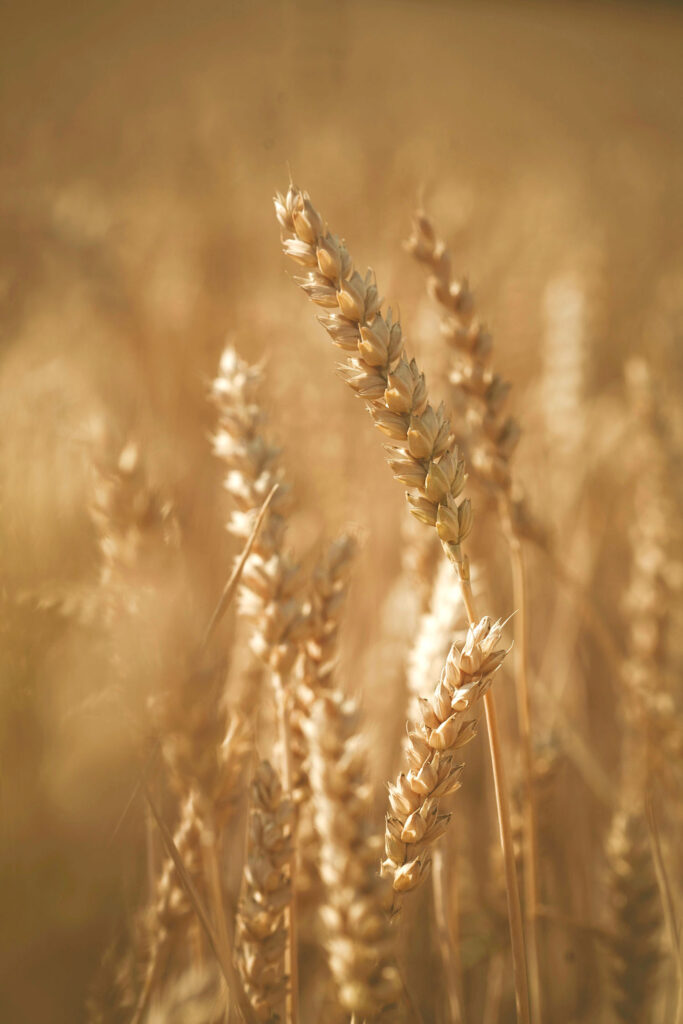From wheat, we bake bread. Our ‹daily bread› represents our daily nourishment in general. But where does wheat for bread come from? Of course, from farmers’ wheat fields. But for many people who eat bread every day, the fields ‹their› wheat is grown on are far away, for example in Ukraine or even in Russia.
For instance, 90 percent of the wheat consumed by Egypt’s 100 million inhabitants comes from Ukraine and Russia. The situation is similar in Lebanon, Morocco, and other countries. In these countries, a lot less wheat is grown than is consumed. In Ukraine, in turn, far more wheat is grown than is consumed in the country, and thus a lot of wheat can be exported. The trading of wheat and other staple foods established in times of peace is now disrupted by war. Cargo ships cannot leave Odessa and other ports in the Black Sea because sea routes are mined with bombs. And thus no wheat ships arrive in Beirut and Alexandria. That is the current drama around wheat.
There is a shortage of wheat on the world market due to the situation in Ukraine. What’s more is the uncertainty of how the harvest in 2022 will turn out. Can sowing take place, can fertilizing take place, and can harvesting take place? Russia produces the most nitrogen fertilizer in the world. In many countries, fertilizer is becoming scarce due to mutual sanction policies. Prices in the agricultural sector have already risen sharply. There is instability, uncertainty, speculation, and the ghost of a hunger crisis looms on the horizon. Officials for the UN World Food Programme are sounding alarms because approximately 20 million tons that are still in storage in Ukraine are so desperately needed for their aid program, for example in East Africa, where more than 20 million people are suffering from famine due to a massive drought.
Is Organic Farming to Blame?
Werner Baumann spoke out on the 19th of March. Baumann is head of the multinational pharmaceutical and agricultural company Bayer, which gained recognition in 2018 for the acquisition of Monsanto, the manufacturer of the broad-spectrum herbicide Roundup. «We are already in a state of crisis with regard to grain supply,» he said, expressing concern about impending hunger for many millions of people. He considers the forced mechanization of agriculture to be a strategic solution, for example through genetically modified wheat that can bind nitrogen like legumes, through smart farming – which requires artificial intelligence in agricultural technology – or through training programs for 100 million small farmers. This sounds like a revival of the Green Revolution, whose promises were never fulfilled. On the 8th of May, Erik Fyrwald, CEO of Syngenta, issued a statement that culminated in an accusation against organic farming. It is to blame for hunger in Africa, he said, because the yield per hectare is only 50 percent of that of chemical farming. (In reality, the average yield for all crops is 81 percent, with much lower energy usage and a much better overall ecological balance.) Fyrwald, like his colleague from Bayer, argues for an approach based on eco-technology.
A further reaction can be seen in the farming community and its lobby: those who are productivist and consider ecological requirements as a nuisance now have the upper hand. In parliaments, commissions, and administrations, many ecological programs are being questioned. The reasoning is simple: hunger is imminent, so as much as possible should be produced on as much land as possible. These are the beginnings of a wartime food industry in correlation with ubiquitous rearmament.
The most recent reaction is from the political realm. At the G7 summit in Germany on the 14th of May, terms such as ‹grain war› and ‹war with food› were used. Those responsible speak apocalyptically of a ‹Third World War, over bread›. Joe Biden is seen in casual attire in the field with U.S. farmers. He will support them financially so that they can produce for the world. India, on the other hand, has just imposed an export ban for wheat, as the soil has dried out after record temperatures in April and supplies are needed in their own country.
Crisis Resistance Through Regional and Organic Cultivation
Due to its black earth soil, Ukraine has the best agricultural conditions imaginable, and wheat, which is challenging to grow, is well alternated with sunflower or corn in these conditions. These goods are storable and thus tradable and account for 10 percent of Ukraine’s gross domestic product. To this end, it is important to know that, in a sense, export agriculture is industrialized on a large scale. This was already the case in communist times, and today collective farms have been replaced by ‹agricultural societies›, which are usually equipped with capital that comes from the West, China, or so-called oligarchs. Organic farms also exist in Ukraine, as do small farmers, agronomists, and farm managers who attend introductory Biodynamic courses. A 400-hectare farm in Potutory, Western Ukraine is Demeter certified and economically backed by a Swiss association.

Agricultural exports like those from Ukraine are needed to feed the world, provide emergency hunger relief, and bridge imbalances caused by demographic trends, such as is happening in regions of Africa where populations are growing rapidly. There is a risk that this will create structural dependence for entire countries. In Egypt, wheat ships from Ukraine have to be unloaded every week, otherwise, there is no bread. It is a ticking time bomb, socially. Accordingly, the price of bread has now also been frozen by the Egyptian government. If it were to rise in line with the increase in the wheat price, an uprising would be inevitable. The current time of crisis brings to light what people tend to forget in times of peace: the food industry must be regionally anchored, to a certain extent. We are now learning that global trade does not always work, even for processors and spare washing machine parts. In regard to food, interrupting supply chains would be fatal.
In addition to an appropriate regionalization of the agricultural and food industry, there is also a need to make it green. Climate change, soil erosion, and biodiversity loss are already causing hunger and hardship and will continue to do so in the future. Organic and biodynamic cultivation is particularly powerful here, as it has a positive climate and ecological balance in many areas, even as yields are 20 percent lower. Organic food can feed the world, but not alone – at the same time, moderate meat consumption must be implemented and food waste must be reduced. In this context, it is worth mentioning that up to half of the world’s wheat is fed to livestock. And believe it or not, ‹heating with wheat› is a reality in many Bio-Gas plants.
A core strategy for sustainable agriculture was already phrased in the 2008 World Agriculture Report: it should be regional, ecological, multifunctional, and based on experience. The extent to which proposals made by multinational agricultural companies are in line with this must be investigated. After all, we live on the same planet. At the same time, I believe that we should not consider the Biodynamic approach a niche market. It has the potential to make contributions to epochal challenges in the agriculture and food industry. Accordingly, I am articulating a ‹wheat strategy› in seven key aspects:
Key Aspects of a Biodynamic and Associative Wheat Strategy
Providing Locally Adapted Varieties
Not all wheat is the same. There are many varieties that have been developed by cereal breeders. For more than 40 years, professional Biodynamic cereal breeding has existed – in Switzerland it is done by the Getreidezüchtung Peter Kunz, GZPK, which among other things has brought the successful Wiwa variety to the market, which has proven to generate stable yields – particularly under difficult climatic conditions – for the farmer, miller, and baker. Know-how for site-adapted crop breeding with high food quality is now also being applied and taught in Italy and Egypt for durum wheat. Using regional training centers, it would be absolutely possible for young agronomists and vigilant practitioners to learn the basic steps of this phenomenological method. Thus, by means of such training centers – one is being established in Sekem in Egypt – responsibility for regionally adapted varieties could be placed into the hands of the people, who can use them to cultivate their fields and produce their bread.
Cultivation in Systems with Balanced Nitrogen Supply
Wheat, being a challenging crop, especially needs sufficient nitrogen from the soil to produce satisfactory yields, both in terms of quantity and quality. If one does not want to or cannot use chemical fertilizers, one must find other sources of nitrogen supply. The legume plant family can ‹inhale› atmospheric nitrogen N2 and incorporate it into the organic process. The task now is to grow legumes in smart combination with grains so that nitrogen is available for wheat growth and yield. One option is to grow legumes – peas, beans, clovers – as a preceding crop; the following wheat can then benefit from the nitrogen enrichment. A second direct option is mixed cultivation of grains and legumes. In the process, the two partners must be well harmonized. For example, a common mixture is barley and peas. A third option on farms with integrated livestock production is to grow forage mixtures with clover and alfalfa species that build up the soil and enrich it with nitrogen over the course of two years. This is already traditionally done: while driving through the Nile Delta in Egypt, you can see golden-yellow wheat fields alternating with deep green fields on which Alexandrine clover grows.
Fertilization with Compost
Building and maintaining soil fertility over the long term requires more than nitrogen supply from legumes. A comprehensive and universal source of regeneration for the soil is necessary. It is possible to tap into this source by making compost. Any organic material can be turned into fresh humus through composting. Composting is possible anywhere and at any scale. It is a learnable craft for every farmer, in every municipality, and even for larger farms. Compost is especially valuable when animal manure can be added or when manure is maintained and applied to fields as fertilizer.

Preparations and Health Management
Every cropping system requires resilience and forces for health. In using Biodynamic preparations, one has a technique that delivers proven results and is freely available everywhere and to everyone. Horn manure preparations support plants in connecting their roots with the soil, and horn silica preparations help plants deal with light and heat. Using compost preparations has a salutogenic effect on the whole farm. In addition, there are regional variations for handling special types of compost, often as an evolution of traditional practices, such as Cow-Pat-Pit (CPP) in India. In warmer climates, application of medicinal herb teas via foliar sprays is also an effective means of directly compensating for weaknesses in a crop.
Local and Regional Processing
After harvesting is completed, the question is where to clean and store the wheat. If this first stage of processing is carried out on the farm, in the village, or in the region, much is gained, because if they are stored dry and pest-free, these grains can be kept for future bread almost indefinitely, without any loss. Local or regional infrastructure for storing wheat can be established anywhere. This also applies to grain milling. Fresh milling and conservative sifting yield much more nutritious flour than standardized white flour. These are critical factors as we look for ways to strengthen food security by means of a regional grain economy.
Associative Markets
The journey from field to plate is often long, as we’ve seen in the example of Ukraine and Upper Egypt. The many stages of intermediate trade can reduce or increase the price, depending on what is included in the economic accounting. In any case, trade routes are only crisis-resistant to a certain degree, as we are now experiencing, and a certain extent of regional supply in the food economy – where our ‹daily bread› is at stake – is quite reasonable. A shorter path makes many things easier and more manageable. Farmers tend to get too little for their products, and consumers pay too much for food. The economic conditions of an industrial and consumer society led to this circumstance. The agriculture and food industry only fit into this to a very limited extent. In part, economic forms other than the free globalized market are necessary. The World Agriculture Report developed the concept of food sovereignty. In terms of food policy, the value of food systems is increasingly recognized – at the regional level, there are some examples of associative cooperation in the value chain, and at farm level a lot of experience with community-supported agriculture (CSA) has already been made.
Innovative Grain Cuisine
Wheat and other grains are a universal basis of our daily food. The processing options go far beyond white bread leavened with yeast – although a baguette now and then is not to be scoffed at. The long rising of the dough during baking, especially with bran and wholemeal flour, unlocks the highly concentrated grain power and offers a variety of enjoyable breads. In addition, there are specialties such as crispbread or pumpernickel. From Italy, pasta made from durum wheat has found its way into ‹world cuisine›. Many grains can be pressed into flakes. In the Maghreb there are many dishes made of grits, semolina or couscous. In short, an innovative grain cuisine, as the seventh step of this wheat strategy, once again holds a lot of potential for a safe, diverse and healthy diet that is accessible to all.
Wheat as a Cultural Vehicle
Wheat is an ancient crop that can be traced back to the Neolithic period. It is more challenging to grow in its position between other grains such as barley, rye and oats, but more balanced and versatile as a food. The black earth soils of Ukraine are by nature ideally suited for wheat cultivation, though when using a well-developed cultivation approach, wheat can be grown in many other locations. Wheat is a great representative of the inauguration of agriculture in ancient Persian culture and its development since then. Plowing allows light, air, and warmth to enter the soil, and the wheat seed brought in produces multiple yields. The transforming power of soil can be found in the corns of the ear. If bread is baked from it, it forms the basis of clear earthly consciousness that has increasingly emerged in cultural development since the transition from nomadism to sedentarism. We are still in the same flow of things today. Even today, this earthly waking consciousness – combined with inner sincerity – is the basis for broadening horizons into the spiritual world. It is wheat that provides the nutritional basis to live and judge prudently and in an open-minded manner in current times. Translator: Simone Stadlbacher






Certainly US/UK involvement in Ukraine, and the strange and horrific scenario being played out in Ukraine, with horrific suffering and death, it is an opportunity to move away from a dependence on produce from Ukraine. And bio biodynamic is certainty the healthiest way forward.
One thing about organic at 81% of yeild, is most modern farmed produce has a higher content of water and a weaker fibrous structure. Modern farming can’t compete with Bio/Organic farming at any level. It can’t make you or the land its is grown on healthier eaither.
I loved to know about the CSA initiative in the West part of the world, Japan and also Korea. I’m quite sure most people never heard it, including myself.
I’ll spread this article here in my Biodynamic association in Brazil. Having my own japanese side it makes me proud of those women in a country where woman were left behind to mainly houseworking tasks.
Thank you for sharing.